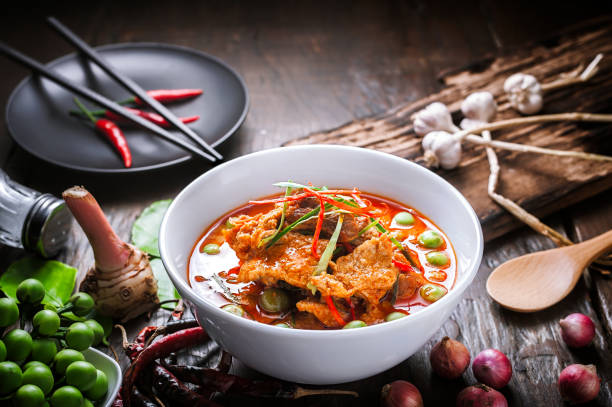Thai curry is a delightful blend of bold flavours and creamy textures, cherished by food enthusiasts around the globe. With its perfect balance of spicy, sweet, salty, and sour notes, Thai curry showcases the essence of harmony in every spoonful. Preparing restaurant-quality Thai curry at home may seem challenging, but it’s surprisingly straightforward once you’ve mastered the techniques and sourced the correct ingredients. This guide will walk you through the process of creating authentic Thai curry in your kitchen.
Understanding Thai Curry Varieties
Thai cuisine boasts several distinct curry styles, each offering a unique taste experience. Here are the most popular types:
- Red Curry: Characterised by its fiery hue, it features red chillies, creamy coconut milk, and aromatic spices.
- Green Curry: Known for its vibrant green colour, it combines fresh green chillies, Thai basil, and kaffir lime leaves.
- Yellow Curry: A milder, slightly sweet curry, coloured with turmeric.
- Massaman Curry: A rich, aromatic curry influenced by Indian flavours, with spices like cardamom and cinnamon.
- Panang Curry: Creamier and sweeter than red curry, often with a nutty undertone.
Your choice of curry will depend on your taste preferences and the ingredients available to you.
Essential Ingredients
To recreate authentic Thai curry, you’ll require these staple ingredients:
- Coconut Milk: Forms the creamy base of the dish.
- Curry Paste: The foundation of the flavour; available in red, green, or yellow.
- Fish Sauce: Provides a savoury, umami richness.
- Palm Sugar: Adds a hint of sweetness.
- Aromatics: Lemongrass, kaffir lime leaves, galangal, and fresh Thai basil.
If these items aren’t readily available locally, consider sourcing them online from Tiger Tiger Foods or JK Foods. If needed, you can substitute ingredients—for example, using ginger instead of galangal or brown sugar in place of palm sugar.
Choosing the Right Curry Paste
The curry paste is the heart of any Thai curry. When selecting one, you have two options:
- Store-Bought: Brands such as Mae Ploy and Thai Kitchen are excellent choices for achieving authentic flavours.
- Homemade: Making curry paste from scratch allows for fresh, vibrant flavours and gives you complete control over the spice levels. Use a mortar and pestle for the best results.
Prepping Ingredients for Success
Preparation is key to ensuring your cooking process runs smoothly.
- Vegetables: Chop evenly to ensure they cook uniformly.
- Proteins: Whether you’re using chicken, beef, prawns, or tofu, marinate them lightly to enhance their flavour.
- Herbs: Always opt for fresh Thai basil and kaffir lime leaves to maximise aroma and authenticity.
Cooking Techniques
Here’s how to prepare Thai curry like a professional chef:
- Cook the Curry Paste: Heat oil in a pan and sauté the paste until aromatic.
- Incorporate Coconut Milk: Gradually add coconut milk, stirring to create a smooth and creamy base.
- Add Proteins and Vegetables: Introduce your choice of proteins and vegetables, cooking until tender.
- Season and Balance: Adjust the flavours with fish sauce, sugar, and lime juice as needed.
Balancing Flavours in Thai Curry
Achieving the perfect balance of flavours is essential for restaurant-quality Thai curry. Here’s how to balance the key elements:
- Sweet: Add palm sugar or brown sugar.
- Salty: Use fish sauce or soy sauce.
- Sour: Incorporate lime juice or tamarind.
- Spicy: Adjust with fresh chillies or chilli paste.
Taste frequently and tweak until the flavours sing in harmony.
Popular Thai Curry Recipes
Red Thai Curry with Chicken
A classic dish, bursting with bold and vibrant flavours.
Green Thai Curry with Prawns
A refreshing and mildly spicy curry, perfect for seafood enthusiasts.
Vegan Massaman Curry
Rich, hearty, and aromatic, packed with vegetables and tofu for a plant-based twist.
Common Mistakes to Avoid
Even experienced cooks can stumble when making Thai curry. Here are some pitfalls to steer clear of:
- Overcooking: Overcooking can dull the vibrant flavours and textures.
- Using Poor-Quality Coconut Milk: Always choose a high-quality brand for the creamiest results.
- Skipping Key Ingredients: Essential items like fish sauce or lemongrass shouldn’t be omitted, as they are crucial to the dish’s authenticity.
Tips for Presentation and Serving
Serving Thai curry with elegance adds to the overall experience. Consider pairing your curry with jasmine rice, sticky rice, or noodles. Garnish with fresh Thai basil, lime wedges, or sliced chillies for an eye-catching finish.
FAQs
1. Can Thai curry be frozen and reheated?
Yes, Thai curry freezes well. Store it in an airtight container for up to three months. Reheat gently on the hob to preserve its flavours and texture.
2. What’s the best way to make Thai curry spicier or milder?
To make it spicier, add fresh chillies or chilli paste. For a milder dish, increase the coconut milk or balance the heat with extra sugar.
3. How can I store leftover curry paste?
Refrigerate it in an airtight container for up to two weeks, or freeze it for long-term storage.
4. What’s the difference between Thai and Indian curry?
Thai curries are typically lighter and more aromatic, using coconut milk and fresh herbs, while Indian curries often rely on cream and dried spices.
5. Can I make Thai curry without coconut milk?
Yes, alternatives like almond milk or cashew cream can be used, though they’ll alter the flavour slightly.
6. Are there gluten-free Thai curry recipes?
Most Thai curries are naturally gluten-free. Just ensure that the curry paste and fish sauce you’re using are free from additives containing gluten.
Conclusion
With the right ingredients, a bit of preparation, and a few key techniques, you can effortlessly recreate restaurant-style Thai curry at home. Don’t be afraid to experiment with different curry types and flavour combinations to make the dish truly your own. Enjoy the satisfaction of mastering this beloved Thai classic in your very own kitchen.

